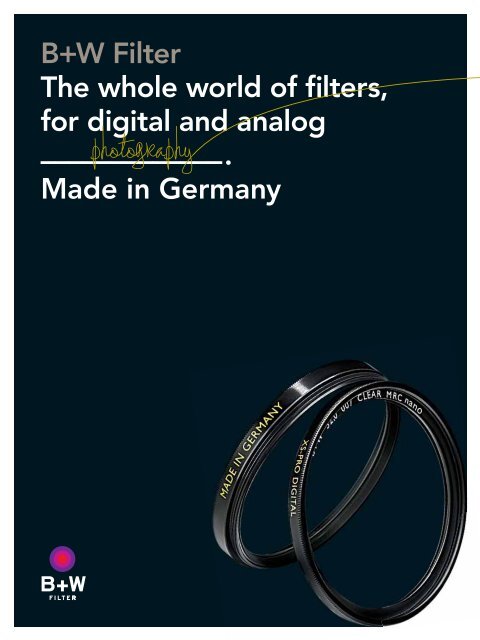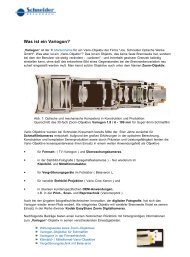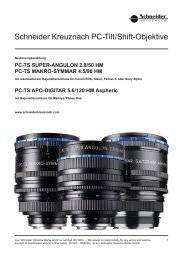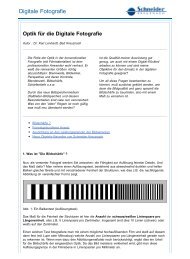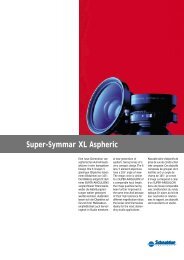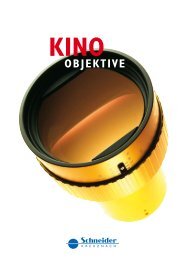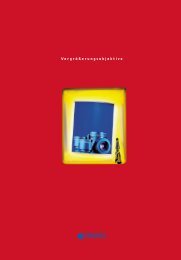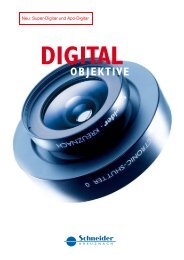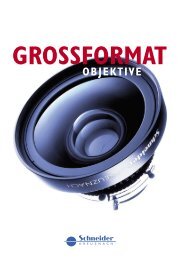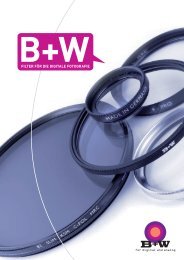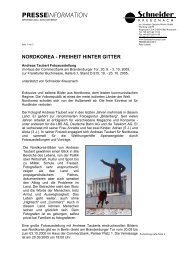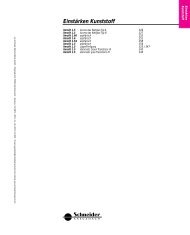The whole world of filters - Schneider-Kreuznach
The whole world of filters - Schneider-Kreuznach
The whole world of filters - Schneider-Kreuznach
You also want an ePaper? Increase the reach of your titles
YUMPU automatically turns print PDFs into web optimized ePapers that Google loves.
B+W Filter<br />
<strong>The</strong> <strong>whole</strong> <strong>world</strong> <strong>of</strong> fi lters,<br />
for digital and analog<br />
photography<br />
––––––––––––– .<br />
Made in Germany
2<br />
B+W Filters: High-tech Made in Germany 3<br />
Mount Types 6<br />
Protection Filters: Clear, UV 10<br />
Polarizing Filters: Käsemann, Circular Polarizing Filters, Linear Polarizing Filters 14<br />
ND Filters, Variable ND Filter 18<br />
Close-Up Lenses: Close-Up and Macro Lenses 22<br />
Effect Filters: S<strong>of</strong>t Focus Attachments, Graduated ND Filters, Redhancer 24<br />
Special Filters: Infrared Filters, Blocking Filters, B+W Filters 28<br />
Accessories 32
B+W Filter<br />
<strong>The</strong> passion for optics,<br />
with precision, quality<br />
and longevity.<br />
High tech made in Germany<br />
––––––––––––– .<br />
since 1947<br />
Innovation and experience<br />
“Made in Germany“<br />
For more than 65 years, B+W <strong>filters</strong> have been synonymous<br />
with quality and innovation. Following the merger with Jos.<br />
<strong>Schneider</strong> Optische Werke GmbH in 1985, the company moved<br />
into its current premises in Bad Kreuz nach. Under the umbrella<br />
<strong>of</strong> <strong>Schneider</strong>-<strong>Kreuznach</strong> a lively technology transfer developed.<br />
B+W has succeeded in establishing itself as one the <strong>world</strong>‘s<br />
leading filter manufacturers. It has, for exam ple, made decisive<br />
progress in surface coating. B+W is the first filter manufacturer<br />
in the <strong>world</strong> to <strong>of</strong>fer MRC (Multi Resistant Coating). MRC nanocoating<br />
is the most innovative development in thin-layer technology.<br />
<strong>The</strong> <strong>world</strong>-famous Käsemann-type polarizing filter with<br />
its outstanding quality has been produced by B+W since 1989.<br />
Today, state-<strong>of</strong>-the-art production equipment, precise CNC<br />
machines and highly advanced reflection-reducing technology<br />
guarantee top quality which is amongst the very best to be<br />
found on the <strong>world</strong> market.<br />
When it comes to technology products, a 65-year company history<br />
is corroboration <strong>of</strong> recognized top quality. Comprehensive<br />
know-how and state-<strong>of</strong>-the-art production technology have made<br />
a name for the proverbial B+W filter quality <strong>of</strong> <strong>Schneider</strong>-<br />
<strong>Kreuznach</strong> throughout the <strong>world</strong>. B+W <strong>filters</strong> also perform<br />
creative tasks in digital photography. Improving photographic<br />
results without touching the data record can only be done with<br />
first-class <strong>filters</strong>. <strong>The</strong> name B+W guarantees perfect image quality.<br />
3
4<br />
Perfection for the light, all the best for the picture.<br />
For example with surface coating technology:<br />
single layer, MRC, MRC nano and MRC IR.<br />
Trust is good, control is better:<br />
B+W <strong>filters</strong><br />
––––––––––––––––
B+W <strong>filters</strong> for better quality in digital photos<br />
Particularly in digital photography, B+W <strong>filters</strong> are important tools<br />
for improving image quality. A B+W polarizing filter, for example,<br />
provides more saturated colors and higher color contrasts<br />
because the bluish-gray haze typical <strong>of</strong> sunny days is filtered<br />
before the image sensor generates the data record. If UV or IR<br />
radiation causes haze or blur a UV/IR blocking filter in front <strong>of</strong> the<br />
lens can ensure more brilliance and detail sharpness without the<br />
necessity for coarsening resharpening in the image program.<br />
Filters solve problems before they occur in the image sensor.<br />
Image-processing programs, on the other hand, cannot conjure<br />
up information which is not contained in the data record. Many<br />
<strong>of</strong> the most commonly used color and contrast corrections work<br />
by removing image information (destructive image correction).<br />
Such, in some cases coarse repairs leave considerable gaps in<br />
the data record which are not yet recognizable on the PC monitor,<br />
but can become visible on the higher-resolution print.<br />
Safety through high-tech production<br />
B+W is the first filter manufacturer in the <strong>world</strong> to <strong>of</strong>fer MRC<br />
(Multi Resistant Coating). This multi-layer coating is vapor-deposited<br />
in highly advanced vacuum coating plants. It is extremely<br />
low-reflective and highly resistant to scratching. But above all its<br />
unique dirt and water-repellent surface makes cleaning the <strong>filters</strong><br />
easier. In this way, <strong>filters</strong> can also perform a protective function<br />
for the front lens.<br />
Refl ection ρ (%) for 2 surfaces while n = 1.52<br />
10<br />
8<br />
6<br />
4<br />
2<br />
0<br />
300 nm<br />
uncoated<br />
single-coated (E)<br />
500 nm 600 nm 700 nm λ<br />
Top performance thanks to Multi Resistant Coating<br />
(MRC)<br />
A key criterion for an outstanding filter is the coating. Quality<br />
begins in front <strong>of</strong> the lens, and that is, <strong>of</strong> course, where the filter<br />
is placed. A filter must not impair the performance <strong>of</strong> the optics.<br />
MRC (Multi Resistant Coating) have a multicoating layer on both<br />
sides (7 + 1 on each) which ensures maximum reflection reduction<br />
and thereby eliminates disruptive stray light. In this way, more<br />
brilliant colors and higher contrasts can be attained. Due to the<br />
low residual reflection (0.5 %) MRC reliably prevents ghost or<br />
multiple images which can be caused by back reflection from the<br />
image sensor.<br />
Furthermore, MRC protects the filter from scratching with<br />
increased layer hardness, thereby preserving the high optical<br />
quality. In addition, MRC is dirt and water repellent, which makes<br />
cleaning easier.<br />
<strong>The</strong> MRC nano coating – all XS-Pro Digital <strong>filters</strong> have it. <strong>The</strong> outer<br />
layer <strong>of</strong> MRC nano has been strengthened in its effectiveness.<br />
<strong>The</strong> nanotechnology-based characteristic (lotus effect) produces<br />
a better beading effect in water. This makes cleaning the filter<br />
surface even simpler and faster. <strong>The</strong> hydrophobic surface reduces<br />
fogging. During the transition from a cold to a warm environment,<br />
the fogging on the filter glass surface dissipates within a very<br />
short time.<br />
B+W B+W<br />
MADE MADE IN IN GERMANY<br />
GERMANY<br />
On an uncoated fi lter or a fi lter with standard<br />
coating (E) the water drop remains fl at. <strong>The</strong>re is<br />
no dirt- or water-repellent effect.<br />
B+W B+W<br />
MADE MADE IN IN GERMANY<br />
GERMANY<br />
B+W B+W<br />
MADE MADE IN IN GERMANY<br />
GERMANY<br />
B+W B+W<br />
MADE MADE IN IN GERMANY<br />
GERMANY<br />
B+W B+W<br />
MADE MADE IN IN GERMANY<br />
GERMANY<br />
On a fi lter coated with hydrophobic material<br />
(MRC) the water drop is noticeably fl atter. It<br />
B+W B+W<br />
MADE MADE IN IN GERMANY<br />
GERMANY<br />
beads <strong>of</strong>f the surface. <strong>The</strong>re is a dirt- and waterrepellent<br />
effect.<br />
B+W B+W<br />
MADE MADE IN IN GERMANY<br />
GERMANY<br />
B+W B+W<br />
MADE MADE IN IN GERMANY<br />
GERMANY<br />
BB+W B+W<br />
MADE MADE IN IN GERMANY<br />
GERMANY<br />
On a fi lter coated with super-hydrophobic material<br />
(MRC nano) a water drop remains practically<br />
spherical. It rolls <strong>of</strong>f the surface. <strong>The</strong>re is an outstanding<br />
dirt- and water-repellent effect.<br />
5
6<br />
Matte black surface to prevent reflections
B+W Filter – quality without edges<br />
perfection<br />
for optical ––––––––––––––––––––––––– .<br />
Threaded fi lter mounts.<br />
B+W quality: A brand that keeps its promise<br />
<strong>The</strong> quality <strong>of</strong> high-grade <strong>filters</strong> is determined by various criteria.<br />
Many photographers are aware that the plane parallelism and<br />
transmission properties <strong>of</strong> glass and the coating are key factors<br />
for image quality. What fewer <strong>of</strong> them know is that the filter mount<br />
must also meet high requirements as a link in the high-tech chain.<br />
<strong>The</strong> main purpose <strong>of</strong> the mount is to hold the fragile filter glass in<br />
place, firmly yet without play, for a long time. However, the glass<br />
must not be subjected to mechanical tension because even the<br />
tiniest deformations can result in visible unsharpness. Nevertheless,<br />
the filter must also be able to withstand a strong grip. And<br />
even after frequent use it must ensure easy and precise attachment<br />
and removal. A non-slip surface quality makes handling<br />
easier. <strong>The</strong> mount thickness should be kept to a minimum in order<br />
to prevent vignetting at short focal lengths.<br />
B+W filter mounts meet these requirements to perfection. As a<br />
rule, they are made <strong>of</strong> brass on highly accurate CNC machines.<br />
<strong>The</strong> filter glass is kept in place securely but without tension by a<br />
threaded retaining ring that is manufactured with equal accuracy.<br />
Fine grooving (knurling) on the front makes attachment easier.<br />
Black (or silver) hard-chrome plating, clearly legible labeling (and<br />
usually matte black inside surface) ensure lastingly stable image<br />
quality and functionality.<br />
To avoid vignetting in the image corners at extreme wide angles<br />
despite the slim design, B+W provides various mount types that<br />
cater for the different angles <strong>of</strong> view.<br />
Precision-engineered mounts<br />
<strong>The</strong> stable brass mounts are made on high-precision CNC<br />
machines. Knurling on the front edge ensures non-slip handling<br />
when attaching and removing. Strict quality controls guarantee<br />
exact adherence to the target values.<br />
Creative filter technology –<br />
the fascination <strong>of</strong> precise design<br />
Behind the globally recognized B+W filter quality is a continuous<br />
process <strong>of</strong> optimization and quality control which already begins<br />
with the raw glass blocks. For the production <strong>of</strong> the high-precision<br />
B+W <strong>filters</strong> Schott colored glass is used almost exclusively<br />
because Schott guarantees the very highest glass quality.<br />
In Bad <strong>Kreuznach</strong>, computer-controlled grinding and polishing<br />
machines produce the highest filter quality from this raw<br />
material in an impressive range <strong>of</strong> designs and diameters. Special<br />
production processes remain the domain <strong>of</strong> the optimizing<br />
handcraft <strong>of</strong> experienced specialists. Strict quality checks in all<br />
key production steps ensure seamless production standards.<br />
B+W quality does not come about by coincidence, but is clearly<br />
defined: to manufacture exactly plane-parallel filter discs without<br />
arching or wedge errors (deviating thickness) which could lead<br />
to partial image blurring. <strong>The</strong> filter glass must be completely<br />
smooth, because roughness results in scattered light and an<br />
unwanted s<strong>of</strong>t focus effect. B+W filter glass meets the highest<br />
requirements <strong>of</strong> camera and lens manufacturers and guarantees<br />
optimum imaging quality.<br />
<strong>The</strong> continuous new development and further evolution <strong>of</strong> the<br />
B+W filter models and the final inspection <strong>of</strong> each individual<br />
filter mean that users can always achieve the best possible<br />
photographic results. It is therefore important to give the same<br />
consideration to quality when buying a filter as when selecting<br />
your lenses. 65 years <strong>of</strong> know-how guarantee top filter quality<br />
to meet global market standards.<br />
Close-up and macro lenses provide a simple way <strong>of</strong> exploring<br />
new motif <strong>world</strong>s. With infrared <strong>filters</strong> you make the invisible<br />
visible and create artistic, fabulous images. For high color<br />
contrasts that still look authentic a polarizing filter is still the<br />
best option, despite the possibilities <strong>of</strong>fered by photo-editing<br />
programs. Furthermore, polarizing <strong>filters</strong> can eliminate many<br />
reflections. <strong>The</strong> B+W S<strong>of</strong>t Pro <strong>filters</strong> produce a pr<strong>of</strong>essional<br />
s<strong>of</strong>t focus effect. And for action photography – whether it is<br />
sailing or mountain biking – B+W protection <strong>filters</strong> shield the<br />
front elements <strong>of</strong> expensive lenses from scratches and moisture.<br />
Experience the fascination <strong>of</strong> precise creativity with your digital<br />
camera thanks to high-quality B+W <strong>filters</strong>.<br />
By the way: You will find more <strong>filters</strong> and tips at:<br />
www.schneiderkreuznach.com/fot<strong>of</strong>ilter<br />
7
8<br />
Premium<br />
Mount Types: ––––––––––––––––––––– Line<br />
Filter mounts – the mechanical specialists<br />
<strong>The</strong> important role played by the filter mount and its mechanically<br />
complex task are <strong>of</strong>ten underestimated. Although mounts are<br />
supposed to fix the high-quality filter glass in position “for life”,<br />
they must not cause any sharpness-reducing tension in the glass.<br />
B+W manufactures various mount types, mainly out <strong>of</strong> stable<br />
brass, on CNC machines. <strong>The</strong> filter glass is screwed into a highprecision<br />
retaining ring, applying a pre-specified torque. Besides<br />
the excellent F-Pro standard mount which is suitable for telephoto<br />
lenses up to the most common wide-angle focal lengths, B+W<br />
<strong>of</strong>fers the very flat XS-Pro mount for super-wide-angle lenses.<br />
This eliminates vignetting. For even more extreme focal lengths<br />
there is the oversized mount on which the filter glass protrudes<br />
far beyond the thread <strong>of</strong> the retaining ring (more under “Filter<br />
mounts”). It is the high-grade mounts that finally make a B+W<br />
filter a true piece <strong>of</strong> high-tech that you can rely on for many years<br />
to come.<br />
Premium Line<br />
<strong>The</strong> increasingly short focal lengths <strong>of</strong> zoom lenses for digital<br />
system cameras increase their proneness to vignetting when<br />
attachments such as <strong>filters</strong> are used. For this reason, B+W has<br />
developed the new Premium Line series with an extremely narrow<br />
filter mount: XS-Pro Digital. It is ideal for demanding DSLR<br />
photography with short wide-angle zooms, beginning at 12 mm<br />
(APS format). Despite its small construction depth, this mount is<br />
fully equipped with a front thread for further accessories such as<br />
lens hoods or snap-in lens caps. This filter series is also made <strong>of</strong><br />
brass and comes in matte black to prevent reflections.<br />
Three filter types are available: 007 Clear MRC nano, 010 UV MRC<br />
nano and the XS-Pro Digital polarizing filter. <strong>The</strong> last is supplied<br />
exclusively as a Käsemann-type circular MRC nano polarizing filter.<br />
<strong>The</strong> Premium Line XS-Pro Digital <strong>filters</strong> 007 Clear MRC nano and<br />
010 UV MRC nano are available in Ø 30.5, 35.5, 37, 39, 40.5, 43,<br />
46, 49, 52, 55, 58, 60, 62, 67, 72, 77, 82 and 86.<br />
<strong>The</strong> Premium Line XS-Pro Digital filter AUC Pol Filter KSM circular<br />
MRC nano is available in Ø 49, 52, 55, 58, 60, 62, 67, 72, 77,<br />
82 and 86.<br />
Premium Line XS-Pro Digital<br />
• Narrow, ideal for wide-angle lenses<br />
• Front thread for additional accessories, snap-in lens cap<br />
• Exclusive MRC nano for the highest demands<br />
• Typical B+W precision and top quality<br />
Thickness comparison:<br />
left: standard mount F-Pro<br />
right: XS-Pro Digital<br />
XS-Pro 007 Clear<br />
PREMIUM
Pr<strong>of</strong>essional<br />
Mount Types: ––––––––––––––––––––– Line<br />
B+W Filter Mount F-Pro<br />
<strong>The</strong> Standard Filter Mount F-Pro has high mechanical stability<br />
despite its shallow design. It can be used on most wide-angle<br />
lenses without the danger <strong>of</strong> vignetting. However, exact data<br />
regarding focal length and angle <strong>of</strong> view limitations are not<br />
possible because vignetting depends not only on the height<br />
<strong>of</strong> the filter mount and the angle <strong>of</strong> view, but also on the tube<br />
design <strong>of</strong> the front <strong>of</strong> the lens. As a guide, this filter mount can<br />
be used without vignetting on 35 mm camera lenses (approx.<br />
63° diagonal angle <strong>of</strong> view). In addition, most wide-angle lenses<br />
with 28 mm (approx. 75° angle <strong>of</strong> view) and in many cases even<br />
with 24 mm (approx. 84° angle <strong>of</strong> view) can be combined with<br />
the F-Pro mount without the risk <strong>of</strong> vignetting. <strong>The</strong> same angles<br />
<strong>of</strong> view apply to lenses in digital cameras. Despite the thinner<br />
design, others <strong>filters</strong>, snap caps or lens hoods can be attached<br />
easily and safely to the front thread.<br />
Another advantage <strong>of</strong> the new F-Pro filter mount: the filter glass<br />
is no longer held in place from the front, but from the back by<br />
the retaining ring. This prevents the retaining ring from being<br />
accidentally loosened during the removal <strong>of</strong> an additional filter<br />
or a lens hood that has been screwed in too tightly.<br />
Available in Ø 24, 25,5, 27, 28,5, 30,5, 35,5, 37, 39, 40,5, 43, 46,<br />
48, 49, 52, 55, 58, 60, 62, 67, 72, 77, 82, 86, 95, 105, 112 and 122.<br />
Pr<strong>of</strong>essional Line<br />
• F-Pro, Digital-Pro and special mount<br />
• Large selection <strong>of</strong> diameters and fi lter types<br />
• Optionally coated with E or MRC (for infrared fi lters<br />
also MRC IR), to meet all requirements<br />
• Suitable for wide-angle<br />
• Combinable<br />
PROFESSIONAL<br />
B+W Digital-Pro<br />
Digital photography in particular benefits from quality <strong>filters</strong>.<br />
<strong>The</strong> Digital Pro filter mount is geared specially to the design<br />
and mount diameters <strong>of</strong> digital cameras and camcorders. <strong>The</strong><br />
silver, hard chrome-plating on the outside follows the pale color<br />
trends <strong>of</strong> digital cameras and forms a harmonious unit with the<br />
lenses. In terms <strong>of</strong> its design, this high-quality mount is based<br />
on the F-Pro model. <strong>The</strong>re are currently 13 mount sizes available<br />
between 30 and 62 mm.<br />
B+W Digital-Pro mounts are available with the filter types 010 E,<br />
010 MRC, 486 MRC, Käsemann-type circular MRC and C-Pol E<br />
polarizing <strong>filters</strong>.<br />
With Ø 30, 30.5, 35.5, 37, 39, 40.5, 43, 46, 49, 52, 55, 58 and 62.<br />
B+W oversized wide-angle mount extra-wide<br />
In the super-wide-angle range even narrow mounts such as the<br />
XS-Pro series cannot completely prevent vignetting. For such<br />
extreme special cases we have the B+W oversized filter mount<br />
extra-wide (EW). <strong>The</strong> mount has oversized dimensions. <strong>The</strong><br />
mount and the filter glass protrude beyond the screw-in thread<br />
on the lens side. Even with ultra-short focal lengths with a narrow<br />
tube, this safety gap ensures that light incident at a highly oblique<br />
angle in the corners <strong>of</strong> the image is not impeded. This is necessary<br />
in particular for adjustable view and large-format cameras, as well<br />
as for special panorama cameras.<br />
Available with MRC in EW Ø lens: 49, 52, 55, 58, 62, 67, 72, 77,<br />
82, 86, 95, 105, 110, and 112.<br />
9
10<br />
<strong>The</strong> guardian angels<br />
for lens and image,<br />
the bodyguards against ––––––– :<br />
the protective fi lters<br />
from B+W Filter.<br />
dirt
Active photography demands a great deal <strong>of</strong> cameras and<br />
lenses. It therefore makes sense to protect the sensitive front<br />
element <strong>of</strong> the lens against fl ying sand, dust, fi ngerprints and<br />
water with a fi lter. Filters not only cost a fraction <strong>of</strong> the price <strong>of</strong><br />
a lens, but are also easier to clean. B+W protection fi lters can<br />
remain permanently in front <strong>of</strong> the lens as they are absolutely<br />
colorless, highly transparent and extremely low-refl ective due<br />
to their hard MRC fi nish. <strong>The</strong> optical information reaches the<br />
image sensor uninfl uenced. <strong>The</strong> fi lters have no exposure factor.<br />
Protection factors play a particularly important role In digital<br />
photography. Larger depth <strong>of</strong> fi eld due to small sensors increases<br />
the infl uence <strong>of</strong> front lens soiling on image quality. Particularly<br />
in zoom lenses with low light intensity, fi ngerprints have the effect<br />
<strong>of</strong> reducing sharpness considerably. Frequent cleaning <strong>of</strong><br />
the front lens, however, can not only cause scratching, but also<br />
transport dirt particles or moisture on the edge <strong>of</strong> the mount into<br />
the inside <strong>of</strong> the lens system.<br />
11
12<br />
B+W Protection Filter Clear<br />
This filter fulfils the desire <strong>of</strong> many photo graphers for pure lens<br />
protection without a filter effect. Its only function is to keep dirt,<br />
sand or splashes away from the front lens. <strong>The</strong> extremely clear<br />
special glass with high transmission is MRC or MRC nano-finished.<br />
<strong>The</strong> hydrophobic coating reduces the adhesion <strong>of</strong> particles and<br />
water drops. <strong>The</strong> advantages are easy cleaning and maximum<br />
reflection reduction. Also available for super-wide-angle lenses.<br />
PREMIUM<br />
PROFESSIONAL<br />
B+W Protection Filter UV<br />
<strong>The</strong> classic among the protection <strong>filters</strong> blocks the unwanted UV<br />
component contained in daylight. <strong>The</strong> invisible UV light occurs<br />
more in pure sea air and in the mountains, and can lead to blur and<br />
blue cast. <strong>The</strong> colorless UV <strong>filters</strong> are suitable for both analog and<br />
digital cameras and ensure more brilliant pictures. <strong>The</strong>y can remain<br />
permanently on the lens to protect it from dirt and damage. A highgrade<br />
MRC or MRC nano finish provides optimum reflection<br />
reduction.<br />
PREMIUM<br />
PROFESSIONAL<br />
Tip for fi lter cleaning :<br />
Multi Resistant Coating with pearl effect<br />
To guarantee perfect image quality, <strong>filters</strong> must be kept clean.<br />
This is supported by the hard MRC finish with its dirt and waterrepellent<br />
coatings.<br />
This is the best way to clean <strong>filters</strong>: Never rub <strong>of</strong>f dry, loose dirt<br />
particles, but remove them first with compressed air (if possible<br />
without touching) or a s<strong>of</strong>t lens brush. Breath on the particlefree<br />
filter surface and clean it gently with a s<strong>of</strong>t B+W Photo Clear<br />
micr<strong>of</strong>iber cleaning cloth. For difficult stains, B+W Lens Cleaner II<br />
spray is helpful. Little effort for constantly perfect image quality.<br />
Do not use paper tissues for cleaning as their fibers cling to the<br />
filter due to being electrostatically charged.<br />
B+W Lens Cleaner II Cleansing Spray<br />
Persistent marks on highly sensitive optical surfaces cannot be<br />
removed with a cloth alone. <strong>The</strong> B+W Lens Cleaner II has been<br />
developed for this purpose. It is a cleansing solution with highly<br />
effective cleansing agents which leave no unwanted residue on<br />
the glass. <strong>The</strong> propellant-free pump spray is simple to use, nonflammable<br />
and bio-degradable (without alcohol). Indispensable<br />
for photo trekking or outdoor action photography.<br />
Lens Cleaner II is also suitable for LCD/TFT screens.<br />
You will find further filter accessories on pages 32 and 33.<br />
XS-Pro 007 Clear XS-Pro 010 UV<br />
F-Pro 007 Clear F-Pro 010 UV Digital-Pro 010 UV<br />
MRC nano MRC nano MRC<br />
E MRC E MRC
All photographic<br />
applications<br />
––––––––––––––<br />
for B+W polarizing<br />
fi lters, ND fi lters,<br />
close-up lenses, effect<br />
fi lters and special fi lters.<br />
Not forgetting the<br />
B+W fi lter accessories.<br />
But see for yourself.<br />
13
14<br />
Polarizing Filters –<br />
refl ection reduction par<br />
excellence<br />
–––––––––––––––– .<br />
Radiant white clouds against a deep blue sky or saturated fall<br />
colors are no coincidence. Polarizing fi lters (pol fi lters for short)<br />
block the bluish gray veil from the diffusely polarized light <strong>of</strong> the<br />
sky. <strong>The</strong>y augment the purity <strong>of</strong> true colors and increase color<br />
saturation. Polarizing fi lters are amongst the most important<br />
fi lters in (digital) photography. <strong>The</strong>y can be rotated in the mount,<br />
allowing the visible regulation <strong>of</strong> the elimination effect in the<br />
viewfi nder or on the display. <strong>The</strong> fi lter factor is two to three<br />
f-stops. <strong>The</strong> maximum effect is achieved at a shooting angle<br />
<strong>of</strong> 90° to the sun. For an even effect in the picture, 35 mm<br />
(or 28 mm in 35 mm fi lm format) should be the minimum.<br />
<strong>The</strong> second benefi cial effect <strong>of</strong> pol fi lters is the reduction <strong>of</strong><br />
refl ections on non-metallic surfaces (water, shop windows,<br />
lacquer). Objects behind these surfaces, including writing<br />
behind refl ecting lacquer, are made visible – a fascinating way<br />
to enhance images without using photo editing. Circular pol<br />
fi lters are recommended for digital cameras.
B+W ––––––––––––––––––––––––––––––––– Polarizing Filters<br />
15
16<br />
B+W –––––––––––––––––––––––––––––––– Polarizing Filters
B+W “Käsemann“ Polarizing Filter<br />
For this high-end polarizing filter the foil pieces are selected<br />
individually for maximum color neutrality. Following cementing<br />
between high-grade optical glass, additional grinding and polishing<br />
takes place. This guarantees outstanding sharpness even with<br />
very bright, apochromatic lenses. <strong>The</strong> latest cementing technique<br />
ensures lasting stability even in damp climates. Available in the<br />
Pr<strong>of</strong>essional Line as linear and circular polarizing <strong>filters</strong>, circular<br />
<strong>filters</strong> exclusively with MRC. Available in the Premium Line as<br />
circular polarizing <strong>filters</strong> with MRC nano finish only.<br />
PREMIUM<br />
PROFESSIONAL<br />
XS-Pro AUC Käsemann circular polarizing fi lter<br />
MRC nano<br />
F-Pro AUC Käsemann circular polarizing fi lter<br />
MRC<br />
B+W Circular Polarizing Filter<br />
<strong>The</strong> standard circular polarizing filter is equally suitable for<br />
both analog and digital cameras. Linear polarization can falsify<br />
exposure or AF metering if beams are split inside the camera<br />
(by mirrors or prisms). Circular polarization prevents this, while<br />
otherwise retaining the same effect. <strong>The</strong> B+W Circular Polarizing<br />
Filter is highly effective and is available with a single coating or<br />
with a high-grade MRC finish.<br />
PROFESSIONAL<br />
F-Pro S03 circular polarizing fi lter<br />
Digital-Pro AUC Käsemann circular polarizing fi lter Digital-Pro S03 circular polarizing fi lter<br />
MRC<br />
E MRC<br />
E<br />
17
ND Filters<br />
101, 102, 103, 106, 110 and ND Vario<br />
ND <strong>filters</strong> – creative using less light<br />
ND fi lters or neutral density (ND) fi lters are used if too much<br />
light restricts creative possibilities. <strong>The</strong>y reduce the light in<br />
accordance with their density. <strong>The</strong>y therefore allow longer<br />
exposure times or more widely opened apertures. Applications<br />
are highly varied and in some cases experimental. For very<br />
bright motifs in the snow or on the beach the aperture would<br />
also have to be closed, despite minimum exposure time. This<br />
would mean losing the option <strong>of</strong> short depth <strong>of</strong> fi eld, e. g. for<br />
portraits. ND fi lters can produce wipe effects in movements if<br />
the exposure time can be extended with the required aperture.<br />
A waterfall then no longer appears to be frozen, but as a fl owing<br />
motion. ND fi lters create ingenious effects in architecture or<br />
urban photography. With long exposure times <strong>of</strong> several hours,<br />
people walking through the shot are blurred or not reproduced<br />
at all. For physical reasons, very dense fi lters possess a warm<br />
tone which can be compensated in image processing.<br />
All ND fi lters are available with single coating or high-quality<br />
B+W MRC fi nish.<br />
N.B.: ND fi lters must not be used for direct visual observation<br />
<strong>of</strong> the sun (risk <strong>of</strong> blindness). <strong>The</strong>y allow UV and IR rays which<br />
damage the eyes to pass through.<br />
Special sun fi lters for direct observation <strong>of</strong> the sun are available<br />
from astronomy suppliers.<br />
Transmission τ (%)<br />
100<br />
1<br />
0.1<br />
0.01<br />
Type Optical<br />
density<br />
400 nm<br />
DIN f-stops Filter<br />
factor<br />
110<br />
103<br />
102<br />
LV %<br />
101 0.3 3 +1 2 x –1 50<br />
102 0.6 6 +2 4 x –2 25<br />
103 0.9 9 +3 8 x –3 12.5<br />
106 1.8 18 +6 64 x –6 1,6<br />
110 3.0 30 +10 1.000 x –10 0.1<br />
Type Example<br />
Aperture<br />
8 11 16 22 32<br />
101 1/500 1/250 1/25 1/60 1/30<br />
102 1/250 1/125 1/60 1/30 1/15<br />
103 1/125 1/60 1/30 1/15 1/8<br />
106 1/60 1/30 1/15 1/8 1/4<br />
110 1/8 1/4 0.5 sec. 1 sec. 2 sec.<br />
2 sec. 4 sec. 8 sec. 15 sec. 30 sec.<br />
101<br />
106<br />
500 nm 600 nm 1000 nm λ<br />
19
20<br />
ND Filters 101, 102, 103, 106, 110 and ND Vario<br />
B+W ND Filters 101 and 102<br />
<strong>The</strong> ND filter series begins with low light attenuation. Type 101<br />
reduces the light by exactly one f-stop (filter factor 2x), type 102<br />
by two f-stops (filter factor 4x).<br />
<strong>The</strong> moderate extension <strong>of</strong> the exposure values is recommended<br />
for indoors or outdoor shots with little light. At lower shutter<br />
speeds, creative s<strong>of</strong>t focus effects, wipe effects and flowing<br />
effects for waterfalls can be achieved. Opening the aperture<br />
allows selective focus instead <strong>of</strong> deep focus – a desired effect<br />
when filming videos with DSLRs.<br />
PROFESSIONAL<br />
B+W ND Filter 103<br />
This already quite strong ND filter reduces the light by up to three<br />
f-stops, equivalent to a filter factor <strong>of</strong> 8x. It <strong>of</strong>fers more options<br />
than weaker ND <strong>filters</strong>. This is already sufficient for successful<br />
time-exposure effects, and it can also be regarded as a universal<br />
ND filter in digital photography. White balance with the filter<br />
ensures optimum color neutrality. Tip: Remember to use a tripod<br />
for longer exposure times!<br />
PROFESSIONAL<br />
NEW: B+W ND Filters 103, 106 and 110 available up to Ø 82 and<br />
Ø 67 oversized.<br />
PLEASE NOTE: Gray <strong>filters</strong> must not be used for direct visual<br />
solar observation (risk <strong>of</strong> blinding). <strong>The</strong>y let through UV and IR<br />
rays which harm the eyes.<br />
B+W ND Filter 106<br />
With its light reduction by six f-stops (filter factor 64x) this filter<br />
allows even more extreme experiments. This includes timeexposure<br />
effects such as light trails, flowing effects for moving<br />
water or walking people who become indistinct in s<strong>of</strong>t focus. A<br />
physically induced higher red transmission produces a slightly<br />
warm tone. If necessary, this can be eliminated by white balance<br />
or an image processing program.<br />
PROFESSIONAL<br />
B+W ND Filter 110<br />
With exceptional light reduction by a full ten f-stops (filter factor<br />
1000x) the 110 continues what begins with the 106: experimental<br />
photography with very slow shutter speeds. Continuous light<br />
trails, walking people on roads and squares become indistinct or<br />
even “invisible.“ <strong>The</strong> flowing effect for moving water becomes<br />
even more extreme.<br />
For physical reasons, the filter produces a slightly warm tone<br />
which can be eliminated by white balance or an image processing<br />
program.<br />
PROFESSIONAL<br />
F-Pro 101 ND Filter F-Pro 102 ND Filter F-Pro 103 ND Filter F-Pro 106 ND Filter F-Pro 110 ND Filter<br />
E MRC E MRC E MRC E MRC E MRC
B+W XS-Pro Digital ND Vario MRC nano<br />
Flexible light control without changing <strong>filters</strong>: <strong>The</strong> newly developed<br />
Vario ND filter can be adapted in its effect to a wide range<br />
<strong>of</strong> subject situations and photographic requirements. Portrait<br />
photographers, for example, usually also need large apertures<br />
in bright ambient light in order to separate their model optically<br />
from the background. Using several minutes <strong>of</strong> exposure time,<br />
architectural photographers can make people passing through<br />
the motif “invisible”. In landscape photography, flowing water or<br />
the surface <strong>of</strong> the sea can be made to appear fluffy and s<strong>of</strong>t with<br />
long exposure times: classic situations which make the use <strong>of</strong> an<br />
ND filter indispensable.<br />
Thanks to its infinitely variable density, the first B+W Vario ND<br />
filter can be adjusted exactly to individual requirements. To this<br />
end, it comes with a continuous setting function with which the<br />
photographer can determine the required density between +1<br />
and +5 f-stops. To prevent aberrations, the light reduction cannot<br />
be set beyond a critical level. <strong>The</strong> XS-Pro Digital ND Vario MRC<br />
nano thus guarantees pr<strong>of</strong>essional image results, even with high<br />
filter factors.<br />
XS-Pro Digital ND Vario<br />
MRC nano<br />
Thanks to the double-sided multicoating layer, the proven B+W<br />
MRC (Multi Resistant Coating) nano coating eliminates unwanted<br />
stray light and delivers visibly more brilliant colors and higher<br />
contrasts. Due to the extremely low residual reflection, ghost<br />
or multiple images which occur due to back reflection from the<br />
image sensor are also avoided. <strong>The</strong> outer layer treated with nano<br />
technology (lotus effect) allows water to bead <strong>of</strong>f far better and<br />
makes cleaning the filter easier.<br />
Tip: DSLR photographers should cover or close the optical viewfinder<br />
during longer exposure times in order to avoid measuring<br />
errors. Like all B+W ND <strong>filters</strong> the XS-Pro Digital ND Vario<br />
MRC nano also works on a color-neutral basis. At high densities,<br />
slight chromatic aberrations in the image may occur for physical<br />
reasons. <strong>The</strong>se can subsequently be eliminated with ease using<br />
white balance or by working in RAW format in the image-editing<br />
program. When using a full-frame camera, the focal length should<br />
be no less than 35 mm to achieve maximum image quality when<br />
selecting higher densities.<br />
Available in Ø 52, 58, 62, 67, 72, 77 and 82 mm.<br />
Supplied in a practical B+W transport box.<br />
PREMIUM<br />
21
22<br />
Close-up lenses reduce the minimum focus, produce clear details
Close-Up Lenses – small <strong>world</strong> in XXL.<br />
Close-up lenses – reading glasses for your lenses<br />
Would you like to explore fantastic <strong>world</strong>s in miniature? Close-up<br />
lenses open up new motifs in an inexpensive way. Like reading<br />
glasses, close-up lenses move the focus range into the close-up<br />
zone. <strong>The</strong> effect increases with the diopter number and the focal<br />
length <strong>of</strong> the lens. For shorter focal lengths in digital photography<br />
stronger close-up lenses are therefore recommended. <strong>The</strong> image<br />
scale describes the effect. A scale <strong>of</strong> 1 : 3 renders an object at a<br />
third <strong>of</strong> its original size on the film/sensor. Close-up and macro<br />
lenses are simple aids which are suitable in particular for threedimensional<br />
objects (flowers) and pictorial photography, less<br />
for technical reproduction purposes. Sufficient stopping down<br />
increases the sharpness and the depth <strong>of</strong> field.<br />
Tip: Use a tripod for longer exposure times.<br />
B+W Close-Up Lenses<br />
As clearly illustrated, the stronger the close-up lens, the closer<br />
you can get to the subject with the same distance setting and<br />
the larger the image you can obtain. A longer exposure time<br />
is not necessary. B+W close-up lenses can be combined, but<br />
for quality reasons and to prevent vignetting no more than two<br />
lenses should be mounted over each other. <strong>The</strong> values are simply<br />
added together.<br />
PROFESSIONAL<br />
B+W Macro Lens<br />
With extremely high +10 diopter power this close-up lens goes<br />
beyond the normal scope. Its high refraction is ideal for the short<br />
focal length <strong>of</strong> digital photography. Even at a focal length <strong>of</strong> just<br />
50 mm you enter the macro range, with an image scale <strong>of</strong> approx.<br />
1 : 2. To increase (depth <strong>of</strong>) focus, stopping down by three f-stops<br />
is recommended. If graduated sharpness is part <strong>of</strong> the image<br />
concept, open apertures can also be used.<br />
PROFESSIONAL<br />
Close-up lenses +1, +2, +3, +4 and +5<br />
Macro lenses +10 in special mount Ø 49, 52, 55 and 58 Close-up lense<br />
E<br />
Macro lense 1<br />
1 Made in Japan. 23<br />
E
24<br />
B + W –––––––––––––––––––––––––––––––––––––––– Effect Filters
S<strong>of</strong>t Focus Attachment<br />
<strong>The</strong> term “s<strong>of</strong>t focus attachment“ does not do justice to this<br />
s<strong>of</strong>t filter. <strong>The</strong> filter delivers sharp pictures which are s<strong>of</strong>tly overlaid<br />
with unsharpness. Details such as eyelashes do not taper<br />
into unsharpness, while skin blemishes are gently covered up.<br />
Small mini-lenses are distributed randomly on a precisely planeparallel<br />
glass disc. <strong>The</strong>y scatter the light and overlay the sharp<br />
core image with hazy, diffuse halos. This opens up deep shadows,<br />
while highlights themselves are hardly blurred, but instead form a<br />
shimmering aura in the darker surroundings. Pr<strong>of</strong>essionals, even<br />
in Hollywood films, use these stable glass <strong>filters</strong> when aiming<br />
for perfect beauty shots. <strong>The</strong> effect cannot be achieved with<br />
image-processing s<strong>of</strong>tware (e.g. Gaussian blur). As well as for<br />
portrait photography, s<strong>of</strong>t focus attachments are frequently used<br />
for great effects in landscape shots. <strong>The</strong>y reduce high contrasts<br />
and the light fringes in the backlight are s<strong>of</strong>tened. <strong>The</strong> photographs<br />
take on a gentle, romantic character.<br />
PROFESSIONAL<br />
B+W S<strong>of</strong>t-Pro – precise beauty s<strong>of</strong>tener<br />
A special s<strong>of</strong>t focus attachment with irregularly distributed<br />
micro-lenses on precisely plane-parallel clear glass. <strong>The</strong> sharp<br />
core image is overlaid with a s<strong>of</strong>t unsharpness. Ideal for dreamlike<br />
feminine portraits, s<strong>of</strong>tly shimmering, backlit blond hair, s<strong>of</strong>t<br />
dream landscapes, and all without much loss <strong>of</strong> sharpness. <strong>The</strong><br />
B+W S<strong>of</strong>t Pro largely retains the overall contrast, working almost<br />
independently <strong>of</strong> focal length and aperture, thereby allowing<br />
control <strong>of</strong> the depth <strong>of</strong> field. It poses no difficulties for aut<strong>of</strong>ocus<br />
systems.<br />
PROFESSIONAL<br />
B+W S<strong>of</strong>t-Image<br />
With the S<strong>of</strong>t-Image in front <strong>of</strong> the lens, the motif contours melt<br />
noticeably more s<strong>of</strong>tly than with the B+W S<strong>of</strong>t-Pro. Very distinct<br />
“glorioles” form around light sources and reflexes and light motif<br />
details acquire a clearly visible light fringe. This effect is also<br />
retained with greater stopping down. Recommended for dreamlike<br />
portraits with back-lighting as it brightens the light fringes<br />
and makes them shine attractively. Not suitable for landscapes<br />
(too s<strong>of</strong>t!).<br />
PROFESSIONAL<br />
Cross Screen, 4x, 6x and 8x<br />
B+W effect attachments make unusual photos possible. Suitable<br />
motifs become even more attractive. This results in pictures with<br />
a look that stands out positively when it is consciously employed.<br />
Cross screen <strong>filters</strong> consist <strong>of</strong> high-quality optical glass into the<br />
surface <strong>of</strong> which fine grating structures are integrated. Depending<br />
on the form <strong>of</strong> grating, light sources or bright reflections shine<br />
in a multi-star pattern that surrounds them. It is important that the<br />
light sources are bright and dot-shaped. <strong>The</strong>n the subtly colored<br />
star effect forms in very high definition.<br />
PROFESSIONAL<br />
F-Pro S<strong>of</strong>t-Pro F-Pro S<strong>of</strong>t-Image<br />
F-Pro Cross screen<br />
25
26<br />
B+W ––––––––––––––––––––––––––––––––––––– Effect Filters
Graduated ND fi lters – balance between heaven and earth<br />
Graduated <strong>filters</strong> are colorless and compensate excessive contrasts<br />
between the sky and the landscape. Clouds gain definition,<br />
sky blue acquires depth. <strong>The</strong> <strong>filters</strong> can be rotated in the<br />
mount in order to adapt the graduation to the horizon. Alignment<br />
is performed in the viewfinder or on the camera’s display. If<br />
exposure metering is done through the filter, a minus correction<br />
<strong>of</strong> approx. 0.5 is advisable. <strong>The</strong> graduation is applied by means<br />
<strong>of</strong> thin layer technology. <strong>The</strong> special coating process requires<br />
a special masking. This involves certain production tolerances,<br />
which means that the graduation border is not exactly parallel. As<br />
this transition lies outside the focus range the effect is not visible<br />
and there is no static transition.<br />
B+W Graduated ND Filter 701 – 50 %<br />
<strong>The</strong> neutral-gray half <strong>of</strong> this graduated filter with transparency<br />
<strong>of</strong> 50 % (1 f-stop) darkens the motif area by one f-stop without<br />
changing the colors. If, for example, the sky is too light in relation<br />
to the landscape, this is the ideal value for good cloud rendition<br />
and to prevent the blue sky from becoming too pale due to<br />
overexposure.<br />
PROFESSIONAL<br />
B+W Graduated ND Filter 702 – 25 %<br />
Extremely well defined clouds and a full-bodied instead <strong>of</strong> milky<br />
tone in the sky – these are the effects produced by this already<br />
stronger graduated filter. It attenuates the light in the darkest<br />
zone by two f-stops (transparency 25 %). Very high-contrast<br />
landscape motifs without loss <strong>of</strong> definition become possible.<br />
<strong>The</strong> graduation zone allows some degree <strong>of</strong> tolerance, but for a<br />
natural transition the horizon line should not be positioned too<br />
far from the center <strong>of</strong> the image.<br />
PROFESSIONAL<br />
F-Pro 701 Graduated ND Filter<br />
MRC<br />
F-Pro 702 Gratuated ND Filter<br />
MRC<br />
Redhancer – luminance for warm tones<br />
This special filter intensifies the reproduction <strong>of</strong> orange, red and<br />
brownish color components without completely blocking bluish<br />
components. <strong>The</strong> B+W Redhancer 491 does not achieve its<br />
special transmission through coloring, but through the chemical<br />
composition <strong>of</strong> the glass. Besides landscape and nature motifs,<br />
the filter effect is also suitable for advertising photography. <strong>The</strong><br />
shot appears particularly natural if reddish areas predominate<br />
and there is no pure white in the image.<br />
B+W Redhancer 491<br />
This special filter amplifies the reproduction <strong>of</strong> reddish tones<br />
from orange and red to reddish brown. Autumnal motifs, flowers<br />
or fruit with reddish colors, as well as red-painted objects (cars,<br />
boats) or reddish rocks, all gain luminance. <strong>The</strong> Redhancer 491 is<br />
even more effective in combination with a polarizing filter which<br />
removes the bluish-gray haze. Fabulous autumnal landscapes full<br />
<strong>of</strong> luminance (Indian Summer) can be captured. Filter sequence:<br />
pol filter at the front, with the Redhancer behind.<br />
PROFESSIONAL<br />
F-Pro 491 Redhancer<br />
E<br />
27
28<br />
B+W ––––––––––––––––––––––––––––––––––––––––––––––––– Infrared Filters
Infrared digital – special <strong>filters</strong> for extreme contrasts<br />
<strong>The</strong> two special fi lters Infrared Filter 093 and UV/IR Blocking<br />
Filter perform opposing tasks. <strong>The</strong> UV/IR Blocking Filter 486<br />
blocks unwanted ultraviolet and infrared light components that<br />
can produce ghost images and sharpness-reducing interference.<br />
<strong>The</strong> images gain sharpness, detail and fine color gradations.<br />
Digital cameras have similar <strong>filters</strong> in front <strong>of</strong> the image sensors;<br />
nevertheless, considerable residual transmission is detectable<br />
in the infrared range. A gap that is closed by the UV/IR Blocking<br />
Filter 486.<br />
It is precisely this gap that the Infrared Filters 092 and 093 make<br />
use <strong>of</strong>. Digital cameras with sufficient IR residual sensitivity take<br />
highly typical infrared picture when the visible light is blocked.<br />
<strong>The</strong> black-red Infrared Filter 093 is ideal for this task. <strong>The</strong> image<br />
section is selected and infrared focusing performed before<br />
attaching the filter.<br />
B+W Infrared Filters 092 and 093<br />
<strong>The</strong> B+W Infrared Filter 092, which is almost black but when<br />
placed in front <strong>of</strong> a light source is in fact dark purple. It blocks<br />
visible light up to 650 nm, and only at just under 700 nm it transmits<br />
50 % (hence the dark-red color). For 730 nm to 2000 nm the<br />
transmission is very high with over 90 %. This allows shots <strong>of</strong> the<br />
pure red and infrared image. This IR filter is suitable for most<br />
digital cameras.<br />
<strong>The</strong> IR filter 093 blocks visible light (up to 800 mm) almost<br />
completely. It is dark red, almost black. With analog IR film or<br />
IR-sensitive digital cameras it delivers a fantastic wood effect<br />
(white leaves) and a typically dark sky. <strong>The</strong> exposure values vary<br />
according to the digital camera model being used and are best<br />
determined by experimenting. <strong>The</strong>y are usually in the range <strong>of</strong><br />
a few seconds. Focusing is performed first without a filter using<br />
IR focus correction.<br />
PROFESSIONAL<br />
MRC IR is broadband antireflexion coating which is effective in<br />
the IR range and applied to both sides <strong>of</strong> the IR filter substrate.<br />
<strong>The</strong> surface is dirt- and water-repellent, ensuring simple and quick<br />
cleaning. <strong>The</strong> multicoating that provides excellent image results.<br />
B+W Digital UV/IR Blocking Filter 486<br />
This filter has a steep cut-<strong>of</strong>f effect for unwanted ultraviolet<br />
and infrared light. In digital cameras and camcorders without<br />
full filtering in front <strong>of</strong> the image sensor it prevents color casts<br />
and unsharpness. <strong>The</strong> brilliance and sharpness <strong>of</strong> the images are<br />
increased. This takes place by interference between vacuumdeposited<br />
layers and not by absorption via colored glass. This<br />
principle is ideal for angles <strong>of</strong> view up to 60° or smaller. <strong>The</strong> filter<br />
has no exposure factor.<br />
PROFESSIONAL<br />
Tip: Digital infrared photography<br />
Whether or not a digital camera is IR-sensitive can be determined<br />
with an IR remote control. Instructions can be found on the Internet.<br />
<strong>The</strong> IR focus point is somewhat further away than that for<br />
visible light. With the filter attached, white balance is performed<br />
automatically or (preferably) manually. <strong>The</strong> IR photos are optimized<br />
in the image-processing program: Increase contrast automatically<br />
or in the histogram, convert color images to black and<br />
white or experiment with individual color channels, leaving the<br />
red channel on maximum. No matter whether digital or analog,<br />
infrared photography is experimental by nature.<br />
F-Pro 092 Infrared Filter F-Pro 093 Infrared Filter F-Pro 486 UV/IR Cut Filter<br />
Transmission (%)<br />
MCR IR MCR IR<br />
MRC<br />
300 400 600 700 800 900<br />
Wavelength (nm)<br />
092 092 MRC-IR 093 093 MRC-IR<br />
29
30<br />
Black and White Filters 022, 040, 090, 091<br />
Consciously composed black and white photography enjoys<br />
undiminished popularity. However, the conversion <strong>of</strong> the colors<br />
into gray-scale values does not correspond to the brightness<br />
perception <strong>of</strong> the human eye, in neither film nor digital photographs.<br />
Filters are therefore indispensable for black and white<br />
photography.<br />
A simple rule explains the mode <strong>of</strong> action: <strong>The</strong> filter’s color<br />
is made lighter, the complementary color is made darker. An<br />
apple tree serves as a good example: When using a red filter, a<br />
red apple appears lighter and the green leaves are reproduced<br />
darker. In contrast, a green filter lightens the leaf green and darkens<br />
the red <strong>of</strong> the apple.<br />
Yellow <strong>filters</strong> very visibly increase the contrasts (by darkening<br />
the sky) in landscape photos. <strong>The</strong> pictures gain more brilliance,<br />
with plant green receiving more differentiated reproduction. A<br />
medium yellow filter is regarded as the standard filter in black<br />
and white photography. An orange filter increases this effect,<br />
making a diffuse sky <strong>of</strong> clouds appear much more dramatic. <strong>The</strong><br />
skin blemishes <strong>of</strong> a model (red patches) are also concealed.<br />
<strong>The</strong> group <strong>of</strong> the red <strong>filters</strong> increases this effect to the point <strong>of</strong><br />
estrangement. A summer landscape photo with a cloudy sky is<br />
transformed into a dramatic storm mood (wood effect), and a<br />
dune landscape becomes a moonscape with an almost black sky.<br />
Tip: On digital cameras with a black and white mode you can<br />
achieve these effects while taking the shot and view them on the<br />
camera monitor. Subsequent conversion using image-processing<br />
programs is unnecessary.<br />
Black and white <strong>filters</strong> also improve the resolution and sharpness<br />
<strong>of</strong> the image. With these <strong>filters</strong> the lens is used only in a narrowband<br />
or even monochromatic color spectrum. All the chromatic<br />
aberrations <strong>of</strong> a lens, such as longitudinal and lateral chromatic<br />
aberrations, are significantly reduced or almost completely eliminated,<br />
depending on the filter. Light that was previously filtered<br />
is no longer “available” for aberrations.<br />
PROFESSIONAL<br />
Transmission (%)<br />
100<br />
90<br />
80<br />
70<br />
60<br />
50<br />
40<br />
30<br />
20<br />
10<br />
0<br />
300<br />
F-Pro 022 Light Yellow Filter<br />
022 E<br />
E MRC<br />
F-Pro 090 Light Red Filter<br />
022 MRC<br />
E MRC<br />
Wavelength (nm)<br />
F-Pro 040 Orange Filter<br />
E MRC<br />
F-Pro 091 Light Red Filter<br />
E MRC<br />
400 500 600 700 800 1000<br />
040 E<br />
040 MRC<br />
090 E<br />
090 MRC<br />
091 E<br />
091 MRC
B+W ––––––––––––––––––––––––––– Black and White Filters<br />
Taken with a B+W Light Yellow Filter 022<br />
31
32<br />
Accessories<br />
B+W Adapter Rings<br />
If photo equipment is to include lenses with different<br />
fi lter thread diameters, the B+W adapter<br />
rings can adapt fi lters and supplementary lenses<br />
to different lens diameters. This is less expensive<br />
than buying several lenses with the same fi lter<br />
type – money that would be better invested in a<br />
larger selection <strong>of</strong> fi lters. When buying fi lters, fi rst<br />
check the largest diameter required. When there<br />
are three different diameters to cater for at the<br />
same time, adapter rings can also be combined if<br />
necessary. Increased thickness due to using several<br />
mounts can result in vignetting. B+W <strong>of</strong>fers a wide<br />
range <strong>of</strong> adapter rings.<br />
B+W Photo Clear<br />
Micr<strong>of</strong>i ber Cleansing Cloth1 <strong>The</strong>re is no better cleansing and care cloth for sen-<br />
sitive optical op equipment: <strong>The</strong> B+W Photo Clear is<br />
made from a high-tech micr<strong>of</strong>i ber which is free<br />
<strong>of</strong> chemicals and lint, and cleans gently<br />
but thoroughly. It can be washed in an<br />
environmentally safe manner, and used<br />
aga again and again without losing any <strong>of</strong> its<br />
proper properties – an accessory <strong>of</strong> frequently underestimated<br />
importance for imaging performance.<br />
Available in 17 × 17 cm and 36 × 28 cm sizes, each<br />
with a protective plastic envelope.<br />
B+W Lens Cleaner II Cleansing Spray<br />
Persistent marks on highly sensitive optical surfaces<br />
cannot be removed with a cloth alone. <strong>The</strong><br />
B+W Lens Cleaner II has been developed for this<br />
purpose. It is a cleansing solution with highly effective<br />
cleansing agents which leave no unwanted residue<br />
on the glass. <strong>The</strong> propellant-free pump spray<br />
is simple to use, non-fl ammable and bio-degradable.<br />
Indispensable for photo trekking or outdoor<br />
action photography.<br />
NEW: Lens Cleaner II is also suitable for LCD/TFT<br />
screens.<br />
B+W Collapsible Lens Hoods 1<br />
Collapsible lens hoods are made <strong>of</strong> high-grade<br />
rubber. <strong>The</strong>ir advantage compared to fi xed lens<br />
hoods made <strong>of</strong> plastic or metal is that, in their collapsed<br />
state, they protrude only a short distance.<br />
This means that the lens hood can remain attached<br />
to the lens and, together with the camera, will also<br />
fi t into a tight photo bag.<br />
Lens hoods are usually regarded simply as a kind<br />
<strong>of</strong> sun visor. In fact, stray light occurs not only by<br />
sunlight obliquely striking the lens, but also due<br />
to bright ground surfaces (snow, beach), diffuse<br />
light or (in object photography) bright surroundings<br />
such as a light table. Blocking stray light can<br />
considerably improve the image quality <strong>of</strong> even the<br />
most expensively coated lenses.<br />
• <strong>The</strong> B+W Lens Hood 900 is tailored to standard<br />
lenses and short telephoto focal lengths. Its inner<br />
ribbing enhances the light-absorbing effect <strong>of</strong><br />
the matte black surface. In its collapsed state,<br />
the rubber hood increases the length <strong>of</strong> a lens by<br />
only one centimeter (up to 77 mm fi lter thread).<br />
B+W Metal Lens Hoods<br />
B+W metal lens hoods convey a reassuring, stable<br />
impression by their very appearance. <strong>The</strong> black<br />
anodized aluminum reliably blocks stray light, and<br />
the precision-engineered tubes have black inner<br />
ribs for even greater absorption <strong>of</strong> unwanted light.<br />
Three types are available for numerous fi lter sizes:<br />
• B+W Metal Lens Hood 970, suitable for wide angle<br />
(zoom) lenses up to 70° diagonal angle <strong>of</strong> view<br />
• B+W Metal Lens Hood 950 for standard lenses<br />
and short telephoto lenses<br />
• B+W Metal Lens Hood 960 with a narrower and<br />
longer tube for telephoto lenses
B+W Snap Cap Pro 311 2<br />
Hard plastic cap with two spring-loaded plastic<br />
claws opposite each other that engage the front<br />
thread <strong>of</strong> the lens (or fi lter). Simple removal by<br />
pressing the two buttons together means fast and<br />
uncomplicated one-hand operation. Available for<br />
thread sizes 52, 55, 58, 62, 72 and 77.<br />
B+W Slip-on Front Lens Cap 300<br />
Protective cap made <strong>of</strong> fl exible plastic material that<br />
slips over the outer front rim <strong>of</strong> the lens or fi lter. It<br />
remains in place by means <strong>of</strong> friction <strong>of</strong> the slightly<br />
elastic, slip-pro<strong>of</strong> plastic material. Also very simple<br />
to handle. Available for lens or fi lter front rim diameters<br />
<strong>of</strong> 27, 30, 32, 37, 42, 51, 54, 57, 60 and 70.<br />
B+W Slim Front Lens Cap 305<br />
This cap corresponds in all its features to the 300<br />
except for thickness. <strong>The</strong> Slim 305 is made <strong>of</strong> fl exible<br />
plastic and tailored specifi cally to the fl at Slim<br />
fi lter mounts. This fl at lens cap is advantageous<br />
when the front rim <strong>of</strong> the lens is slightly larger than<br />
the Slim fi lter, so that a normal lens cap could not<br />
be slipped on completely. Available for the following<br />
Slim fi lter mounts 49, 52, 55, 58, 60, 62, 67, 72,<br />
77 and 82, or for the corresponding outer diameters<br />
52, 55, 58, 61, 62, 65, 70, 75, 80 and 85 mm.<br />
B+W Rear Lens Caps 330 to 335 2<br />
Hard protective cover for the camera-side rear<br />
bayonet or thread <strong>of</strong> the lens. Available for lenses<br />
<strong>of</strong> Canon FD (330), Minolta MD (331), Nikon (332),<br />
Pentax K (334) and M-42 thread (335).<br />
B+W Camera Body Covers 320 to 325 2<br />
Hard protective covers for the bayonet or thread<br />
lens mounts on camera bodies. Available for SLR<br />
cameras with the lens mounts Canon FD (320),<br />
Minolta MD (321), Nikon (322), Pentax K (324) and<br />
M-42 thread mounts (325). <strong>The</strong>se camera body<br />
covers can also be used as front protective covers<br />
on tele-converters, provided that their optical systems<br />
are suffi ciently recessed in their mounts.<br />
Nylon Fabric Filter Pouches 2<br />
<strong>The</strong>se fi lter pouches are made <strong>of</strong> padded, heavyduty<br />
and water-repellent nylon fabric with practical<br />
Velcro fasteners and a white space for labeling.<br />
<strong>The</strong>y provide excellent protection for the individual<br />
fi lters. Available in three sizes:<br />
• E 1 11.5 × 11.5 cm for fi lter sizes up<br />
to 77 Ø<br />
• E 2 14.5 × 14.5 cm for fi lter sizes up<br />
to 105 Ø<br />
• E 3 20.0 × 20.0 cm for fi lter sizes larger<br />
than 105 Ø<br />
B+W Filter Pouch B42 and B62 <strong>The</strong> folding, foam-padded pouch made <strong>of</strong> fl exible<br />
plastic p material can hold up to six fi lters. Snap fasteners<br />
tener and transparent inner compartments ensure<br />
quick, q easy access and the secure positioning<br />
<strong>of</strong> the fi lters. When folded, the pouch also<br />
fi ts into the front compartment <strong>of</strong> a photo<br />
bag for fast, convenient removal. Filter pouch<br />
B4 B is suitable for fi lters sizes up to 82 Ø (max.<br />
4 fi lters) and fi lter pouch B6 up to 62 Ø (max. 6<br />
fi lters). lt<br />
B+W Individual Filter Case<br />
B+W provides various cases for the safe, dust-pro<strong>of</strong><br />
storage st <strong>of</strong> fi lters. <strong>The</strong> fl at, handy fi lter cases made<br />
<strong>of</strong> hard but transparent plastic let you see right<br />
away which fi lter is stored inside.<br />
A shock-absorbing foam insert prevents slipping<br />
and rattling. <strong>The</strong> sturdy individual cases are<br />
available in three sizes, with additionally available<br />
inserts reducing the dimensions for smaller fi lters:<br />
• Size BH for fi lters and special effects attachments<br />
up to 52 Ø (with insert up to 48 Ø)<br />
• Size D for fi lters up to 82 Ø (with insert up to<br />
62 Ø)<br />
• Size E for fi lters up to 105 Ø<br />
1 Made in Japan.<br />
2 Made in China.<br />
33
34<br />
You will fi nd overviews <strong>of</strong> the product<br />
range and further information<br />
Internet<br />
on the B+W fi lters on the –––––––––––––––– at:<br />
www.schneiderkreuznach.com/fot<strong>of</strong>i lter
Imprint<br />
Publisher<br />
Jos. <strong>Schneider</strong> Optische Werke GmbH<br />
Geschäftsbereich B+W Filter<br />
Ringstrasse 132<br />
D-55543 Bad <strong>Kreuznach</strong><br />
www.schneiderkreuznach.com<br />
Concept and Design<br />
Scheufele Hesse Eigler<br />
Kommunikationsagentur GmbH<br />
Cretzschmarstrasse 10<br />
D-60487 Frankfurt / Main<br />
www.scheufele-online.de<br />
Photography<br />
Achim K. Rösch (DGPh), title,<br />
pages 4, 6 and product shots<br />
Frank Widmann, page 28<br />
Rolf Nachbar, pages 10 – 11, 16,<br />
18, 22, 23, 24, 26, 31<br />
Radek Plîhal, pages 15, 25<br />
Copy<br />
IdeaTorial Redaktionsteam<br />
Frank Späth<br />
Immenbuschweg 5<br />
D-27389 Vahlde<br />
www.ideatorial.de<br />
Translation<br />
Ian McCaughtrie<br />
D-22926 Ahrensburg<br />
35
Jos. <strong>Schneider</strong> Optische Werke GmbH<br />
Business Unit B+W Filter<br />
Ringstrasse 132<br />
D-55543 Bad <strong>Kreuznach</strong><br />
Phone +49 671 601-122<br />
Fax +49 671 601-302<br />
fi lter@schneiderkreuznach.com<br />
www.schneiderkreuznach.com<br />
2012/07-1066263 a


